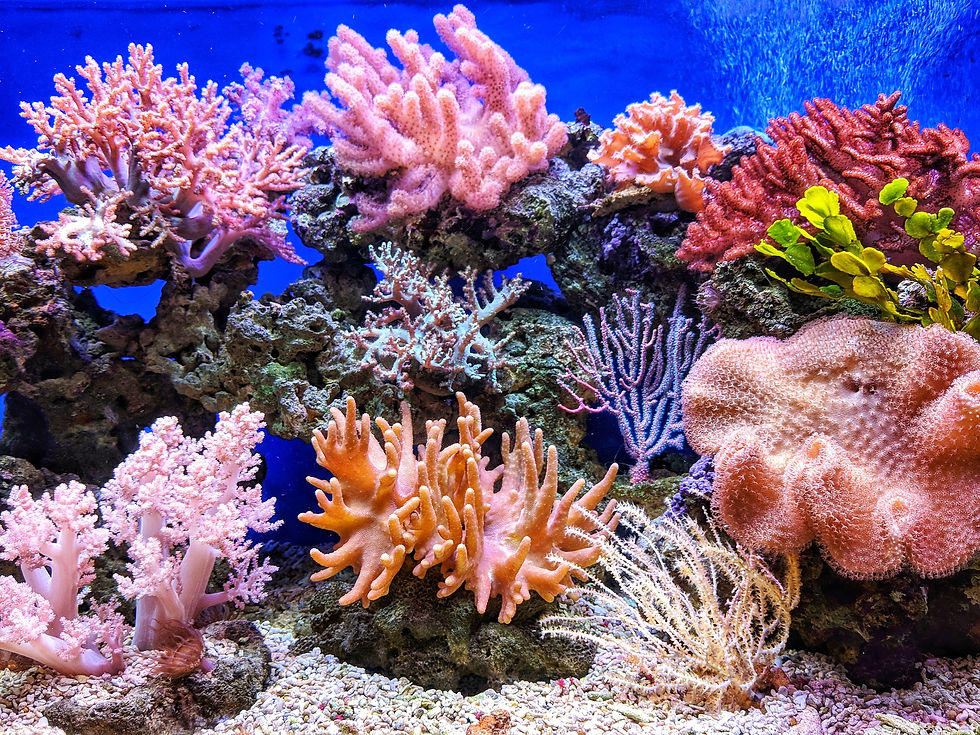A Spotlight On: Designers Inspired by our Oceans
- Grace Cockerill

- Jun 4, 2021
- 4 min read
Updated: Aug 16, 2021
The ocean covers around 71% of the Earth, but only 5% of it has been explored. It is a bustling ecosystem teeming with vibrant marine and plant life. Despite its beauty, it’s estimated that the ocean has 8 million tonnes of plastic waste polluting it.
As a result, brands are starting to change the way fashion is produced, and consumers are choosing more sustainable options – but, there is still work to be done. Here’s three designers who are inspired by our oceans, each in a unique way.
Dimitra Petsa is a London based designer behind the label Di Petsa, inspired by eco-feminist research, exploring the concept of ‘wetness’. Pesta creates hand-draped pieces, usually consisting of white or diaphanous fabrics to emulate the look of being wet.
The aim of Petsa’s work is to destigmatize Western society’s perception of bodily fluids, such as sweat, tears, and lactation. On her final graduate collection, in an interview for Dazed100 Petsa stated:
“It was an eco-feminist research project into how the way we treat our bodily fluids has an immediate connection to how we treat the oceans and water at large…”
Pieces like white, mesh underwear, layered with bold, blue text that read ‘Wet’ make up the ‘Wetness’ collection. The underwear is shown underneath mesh dresses, which are also adorned with blue script taken from Petsa’s performance poetry THE WATER BROKE.
“Our bodily fluids, water filtered through our bodies, bodily water. Holy water, Sea water. If you cry in public you must hide it If you sweat in public you must hide it If you breastfeed in public you must hide it. And our wetness consumes and overwhelms us, turns into rivers and rain, darkened oceans.”
The link between Petsa’s garments and our oceans is clear. Fashion is one of the largest contributors of microplastic pollution into the ocean. Over a third (35%) of all microplastics in the ocean come from the textile industry. We need to take care of our bodies, and take care of the ocean.
Iris Van Herpen is the Dutch designer behind the eponymous label Iris Van Herpen. Starting in 2007, Van Herpen created the brand which fuses modern tech (such as 3D printing and laser cutting) with haute couture. Nature is the key inspiration behind the label. Van Herpen stated “Water, air and earth are elements that leave traces in the sensorial garments”.
The ‘Crystallization‘ collection from July 2010 centred around Van Herpen’s first 3D printed piece – a dress that encompasses the wearer, which looks like a splash of water. The breathtaking garments are clear, and fold and curve around the wearer in various ways.
3D printing is being utilised to regenerate marine life; the Living Seawall is a project where 50 3D printed tiles were placed in the Sydney Harbour to aid biodiversity to create a more healthy, and less polluted ocean.
The tiles are hexagonal and are designed to mimic mangrove jungles. The more organisms that are attracted to the Living Seawall, the more pollution will be filtered out. 3D printing has proven to be a cost-effective, eco-friendly way to help save our oceans.
Another collection by Van Herpen, ‘Sensory Seas’, was designed to highlight the sensory mirroring between our body and the ocean. The collection is made up of flowing garments, with pools of blues and lilacs made of mesh that resemble cellular geometry. Van Herpen states:
“Swaying serenely, they are at the liberty of change, regenerating amongst the immensity of the ocean, to the silent, yet eternal chattering of our senses.”
Mollika Prak is the creative behind the Brisbane based accessories brand Monirath. Monirath has been described as ‘freaky-chic’ jewellery; sculptural pieces that push the envelope and pack a punch. With Prak herself describing the brand as: “Avant-garde. Experimental. Questionable.”
A tweet by Prak went viral in January this year, amassing a whopping 468.8K likes; the subject of the tweet was the Water Hat made by Monirath. A clear, 3D piece made to resemble a splash of water upon the wearer’s head. The hat captures and refracts light onto the face as it is worn, giving an underwater look.
All of the Water Hats are made-to-order, unique pieces – so no two are the same. The piece is secured to the head by a ribbon, giving the hat a delicate feel. Monirath’s beach themed jewellery collection from 2018, consisting of pearl necklaces and starfish inspired earrings, couple with the Water Hat beautifully.
Australia coastal inspiration can be seen in Prak’s work, however, the pollution seen in Australia’s oceans is devastating. As a result, the Great Barrier Reef in Queensland has lost more than half of its corals since 1995 due to the effects of climate change. The reef is not entirely dead however, and the Reef 2050 plan has been set in place to prevent more loss of the natural wonder.
The sooner we turn to more sustainable forms of fashion, the sooner our oceans can begin to heal. Eco-friendly forms of production, such as 3D printing and circular fashion, are ways we can make a change to help to protect our planet.



Comments